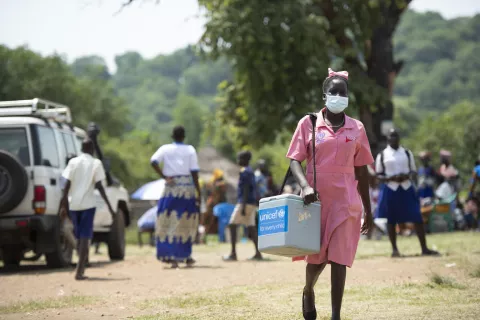UNICEF’s midwifery and obstetric kits: Ensuring a safe childbirth around the world
How UNICEF’s health supplies help prevent maternal and neonatal deaths.

Although more women and children are surviving childbirth than ever before, a pregnant woman or newborn still dies every 11 seconds somewhere in the world, mostly from preventable causes.
Mothers often die as a result of obstetric complications, such as high blood pressure, during pregnancy, and severe bleeding or infections during or after childbirth. About a third of neonatal deaths occur within the first 24 hours and nearly three-quarters in the first week, often from complications during birth or infections contracted after. But had they received skilled care before, during and after childbirth, many lives could have been saved.
For decades, medical kits delivered by UNICEF have been helping to save the lives of mothers and newborns around the world.
How the midwifery kit took shape
The origins of the midwifery kit date back to the 1950s when Leo Eloesser, an American surgeon who served in China with UNICEF, began to experiment with assembling a range of items that a traditional midwife could take to a woman in labour. Originally these items included a sharp knife, gauze, gloves, plastic sheeting and a bottle of antiseptic fluid. The contents of the kit were further refined by Dr Berislav Borcic, who served as Deputy Director-General of UNICEF in the 1950s.
The midwifery kit was soon standardised and pre-assembled, allowing it to be more easily ordered and dispatched all over the world.
The midwifery kit is designed to perform an average of 50 normal deliveries and is intended to be used by trained health personnel, such as midwives, physicians and nurses with midwifery and resuscitation skills. It consists of six different modules containing products such as medical equipment, medicines and disposable materials like gloves and syringes.
The kit can be ordered with its all six different modules or, depending on what the country already has in stock, only with the modules it needs.
Each module supports the overall aim: to save lives, and improve maternal and neonatal care in emergency situations.

Where midwifery and obstetric kits are needed most
A staggering 94 per cent of maternal deaths occur in low- and lower-middle income countries where health systems are fragile, under-resourced and over-stretched - or grappling with a humanitarian emergency. For example, the level of maternal deaths are nearly 50 times higher for women in sub-Saharan Africa, and their babies are 10 times more likely to die in their first month of life, compared to high-income countries.
In 2021, UNICEF delivered 8,307 midwifery kits worldwide. The top five recipient countries were: South Sudan, Ethiopia, Afghanistan, Mongolia and Tanzania.
The midwifery kits are crucial where health facilities are often underequipped, understaffed and a long trek from the communities they serve.
Women may not always safely give birth in these facilities and instead must travel to better-equipped hospitals even further away to deliver their babies, incurring expenses they can ill afford while risking their health and the health of their child.
Anfac Mohammed is one of the lucky ones. The 24-year-old mother recently gave birth to her son, Mohammed Ali, in Gode Hospital, her nearest health facility.
“With equipment provided by UNICEF, I am very grateful that I have not been referred to a distant hospital and I safely gave birth here. Me and my baby are both well,” she said.
A mother’s story from Venezuela
UNICEF also supplies life-saving obstetric kits for use in complicated deliveries. In 2021, UNICEF delivered 1,689 obstetric kits. The top five recipient countries were: Venezuela, Somalia, Sudan, Liberia and South Sudan.
Like the midwifery kit, the kit consists of different modules containing drugs, equipment and renewable materials that are assembled and delivered by UNICEF. The obstetric kits are designed to perform 100 deliveries, including 50 where women in labour face complications and caesarean sections.
Marsolyaire from Caracas, Venezuela, had to deliver her third child, Moises, by C-section at 39 weeks after she began leaking amniotic fluid.
As a nurse, she knows the importance of attending regular check-ups during pregnancy and getting help as soon as complications arise. But Venezuela’s economic crisis has had an enormous impact both on the country’s health system and the ability of women to access care during pregnancy.
“I’m a nurse. I work in the surgical area. I know the critical situation in hospitals,” Marsolyaire said.
UNICEF has been working with partners to strengthen maternal and childcare in Venezuela. In the hospital where Marsolyaire gave birth, UNICEF has provided midwifery kits, vaccines, micronutrients to women and children under five, and supported the birth registration service.
UNICEF standardized kits
The midwifery and obstetric kits are part of a series of standardized kits developed by UNICEF to meet the various needs of children and their families in vulnerable or under-resourced situations. The kits are an invaluable resource in emergency responses as they can be quickly assembled, shipped and distributed. Kit components are sourced from suppliers around the world and are assembled in UNICEF warehouses or locally, thanks to capacity building initiatives in kit assembly, warehousing and distribution.






